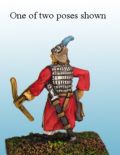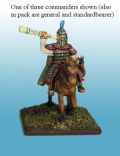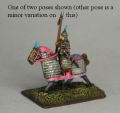Late Tang To Five Dynasties Chinese
Historical Overview Section
The Tang Empire was at its height of power up until the middle of the 8th century when the An Shi Rebellion (755-763) destroyed the prosperity of the empire. An Lushan was a half-Sogdian, half-Turk Tang commander and had had experience fighting the Liao Khitans of Manchuria yet most of his campaigns against the Liao Khitans were unsuccessful. He was given great responsibility in Hebei, which allowed him to rebel with an army of more than one hundred thousand troops. Despite early victories scored by Tang General Guo Ziyi (697-781), the newly recruited troops of the army at the capital were no match for An Lushan's die-hard frontier veterans, so the court fled and called upon the help of the Later Horse Nomad Uyghur Turks in 756. The Later Horse Nomad Uighurs helped recapture the Tang capital from the rebels, but they refused to leave until the Tang paid them an enormous sum of tribute in silk. Even Abbasid Arabs assisted the Tang in putting down An Lushan's rebellion. The Tibetans also spotted an opportunity and raided many areas under Chinese control, and even after the Tibetan Empire had fallen apart in 842 (and the Uyghurs soon after) the Tang were in no position to reconquer Central Asia after 763, although they slowly rebuilt their shattered economy and state structures.
The last great ambitious ruler of the Tang Dynasty was Emperor Xianzong of Tang (r. 805-820). He also had an effective well trained imperial army stationed at the capital led by his court eunuchs; this was the Army of Divine Strategy, numbering 240,000 in strength as recorded in 798. Between the years 806 and 819, Emperor Xianzong conducted seven major military campaigns to quell the rebellious provinces that had claimed autonomy from central authority, managing to subdue all but two of them. But this couldn't last and the empire received another body blow when a series of natural calamities and the Huang Chao Rebellion (874-884) resulted in the sacking of both Chang'an and Luoyang and took an entire decade to suppress. Although the rebellion was defeated by the Tang, it never recovered from that crucial blow weakening it for the future military powers to take over. There were also large groups of bandits, in the size of small armies, that ravaged the countryside in the last years of the Tang, who smuggled illicit salt, ambushed merchants and convoys, and even besieged several walled cities.
In 907, after almost 300 years in power, the dynasty was ended when one of the increasingly autonomous military governors Zhu Wen (known soon after as Taizu of Later Liang) deposed the last emperor of Tang, Emperor Ai of Tang, and took the throne for himself. He established his Later Liang Dynasty, which thereby inaugurated the Five Dynasties and Ten Kingdoms Period but was himself deposed by Li Cunxu who declared himself emperor in 923. The new Later Tang Dynasty had a few years of relative calm, followed by unrest and in 936, Shi Jingtang, a Shatuo Turk was aided by the Manchurian Liao Khitan Empire in a rebellion against the dynasty.
Not long after the Jin Dynasty's founding, the Khitan Liao relegated the role of Emperor to that of a proxy for their own control and in 943 declared war and within three years seized the capital, Kaifeng—thus marking the end of Later Jin Dynasty. But, although they had conquered vast regions of China, they were unable or unwilling to control those regions and retreated from them early in the next year.
There were a load of other dynasties up north in this time, propped up or undermined by the Liao and other Later Horse Nomad regimes. In the south it was less messy, with 10 Kingdoms all holding separate geographical areas. Although more stable than northern China as a whole, southern China was also torn apart by warfare. Wu quarrelled with its neighbours, a trend that continued as Wu was replaced with Southern Tang. In the 940s Min and Chu underwent internal crises which Southern Tang handily took advantage of, destroying Min in 945 and Chu in 951. Remnants of Min and Chu, however, survived in the form of Qingyuan Jiedushi and Wuping Jiedushi for many years after. With this, Southern Tang became the undisputedly most powerful regime in southern China. However, it was unable to defeat incursions by the Later Zhou Dynasty between 956 and 958, and ceded all of its land north of the Yangtze River. The Northern Song Chinese Dynasty, established in 960, was determined to reunify China. Jingnan and Wuping were swept away in 963, Later Shu in 965, Southern Han in 971, and Southern Tang in 975. Finally, Wuyue and Qingyuan gave up their land to Northern Song Chinese in 978, bringing all of southern China under the control of the central government.
Using the army in FoG
- Built on a core of Shooty Cavalry the Tang army can expect to shoot down lots of its more pedestrian opponents.
- Unusually the infantry are light spear/swordsmen in this list, making them still a match for the Hvy Weapon men found elsewhere, although the possibility to take rear rank bowmen is actually better than crossbows against other foot armies.
- The Southern Auxiliary Impact Foot, whilst normally weak in an open context, could be fairly decisive in this book against many possible opponents.
UK Tournament Results with this army
Useful Links
User-contributed links about this army:
- Wikipedia link lots more details
- Tang Chinese DBA Figure Gallery for this army - from Fanaticus
- put the link text readers will see in here write some more detail about the link here
Allies
Put information on allied contingents here - including recommendations on which to use, and why.
Painting and Collecting the Army
- Paint schemes, insignia, shield designs? Put it here.
15mm Manufacturers supplying figures for this army
You can see some of the figures in the Ancients Photo Gallery also on this site
|
|

|

|

|

|
- Essex Miniatures - Tang range
- Magister Militum (includes former Chariot ranges)
- Minifigs UK Tang troops
- Irregular Minis Sung range may be OK
- Outpost Sui & Tang
- Viking Forge Tang armies
- Brial Hall’s Hall of Ancient Warriors Tang
- Miniature Wars
- Gallia Chinese
- Naismith & Roundway Some Song Chinese and Khitans
- Khurasan Miniatures Tang are the latest release from the prolific Khurasan
Army Lists
Sample army lists for this army
Name of Army / Date
- Using asterisks inthe edit mode creates a bulleted list in the actual site
- This is a lot easier to do than easier than setting up tables
- For FoG I suggest listing your army in order or march
- with troop desctiptions on each line, for example
- 4 HF Armoured Average Drilled Impact Foot Swordsmen
- 8 LG Undrilled Unarmoured Poor Bowen
- Dont forget to include your Generals !!!
Include any notes you want here, including comments on how to use - or play against - the army.
Remember to leave a line before you copy the above section as a template for your own list
eBay Listings
UK Bookstore